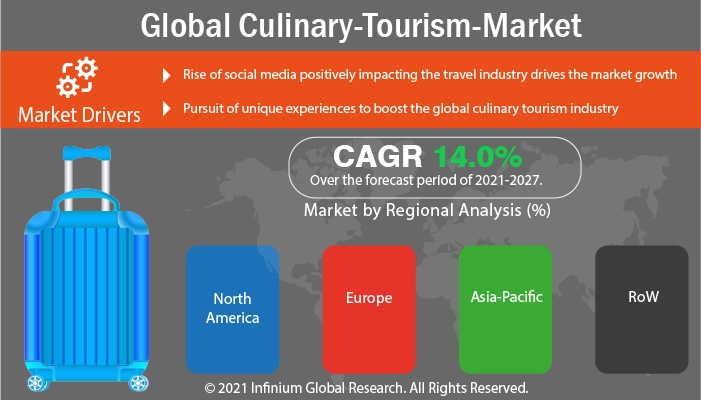Culinary Tourism Market (Activity Type - Culinary Trials, Cooking Classes, Restaurants, Food Festival, and Others; Tour - Domestic, and International; Mode of Booking - Online Travel Agents, Traditional Agents, and Direct Booking): Global Industry Analysis, Trends, Size, Share and Forecasts to 2027
A recent report published by Infinium Global Research on culinary tourism market provides in-depth analysis of segments and sub-segments in the global as well as regional culinary tourism market. The study also highlights the impact of drivers, restraints, and macro indicators on the global and regional culinary tourism market over the short term as well as long term. The report is a comprehensive presentation of trends, forecast and dollar values of the global culinary tourism market. According to the report, the global culinary tourism market is projected to grow at a CAGR of 14% over the forecast period of 2021-2027.
Market Insight
The culinary tourism market was valued at over USD 1000 billion in 2020 and is anticipated to reach up to USD 3000 billion in 2027, growing with a CAGR of 14% during the projection period. Culinary tourism is focused on food as an attraction for consideration and a destination for tourism. Though food has always been a part of hospitality services for tourists, it was not emphasized by the tourism industry. It now includes an assortment of formats and products such as culinary trails, cooking classes, restaurants, farm weekends, cookbooks, food guides, and new or adapted recipes, dishes, and even ingredients. Whereas most culinary tourism focuses on the experience of dining and tasting of new foods as a commercial enterprise, it is also an educational initiative channeling curiosity about food into learning through it about the culture of a specific cuisine, the people involved in producing and preparing it, the food system allowing access to those foods, and the potential contribution of tourists to sustainability.
The culinary tourism market growth can be accredited to rise in instances of people opting for unique and exotic holiday destinations, to get away from the everyday hectic schedule and gain valuable experiences. Private, quite, serene, and exotic locations with a predominant food culture are the major factors that people consider while picking their travel location. Furthermore, regions with a large variety of food and drinks that taste unique have been voted as a top preference by the travellers. Moreover, destinations that are culturally and traditionally intriguing are becoming popular among affluent travellers, due to the rising interest of people to learn and understand the local culture. Additionally, the rise in the exposure of people to different forms of social media has enhanced their knowledge about numerous trends shaping the tourism industry. On the other hand, political unrest and terrorism have affected the overall volume of foreign trips and choice of destination and are the major limiting factors for the culinary tourism market. In contrast, an increase in affordability and convenience in finding accommodation is anticipated to encourage budget travellers to tour more often and make way for the growth of the culinary tourism market.
Among the geographies, the Asia Pacific region is expected to hold the largest share in the global culinary tourism market owing to the growing consumer preference to visit the countryside which has increased global sales of culinary tourism. Furthermore, the region is also projected to witness high growth in the global culinary tourism market due to increasing on-going investments in the food and hospitality industry across developing countries, such as China, India, and Japan. However, the European region is expected to grow with a substantial CAGR in the culinary tourism market during the forecast period. The European regional share is escalating owing to the presence of a large number of traditional food outlets and easy availability of accommodation.

Segment Covered
The report on global culinary tourism market covers segments such as activity type, tour, and mode of booking. On the basis of activity type, the sub-markets include culinary trials, cooking classes, restaurants, food festival, and others. On the basis of tour, the sub-markets include domestic, and international. On the basis of mode of booking, the sub-markets include online travel agents, traditional agents, and direct booking.
Companies Profiled:
The report provides profiles of the companies in the market such as Abercrombie & Kent USA, Classic Journeys, G Adventures, Greaves Travel, India Food Tour, ITC Travel Group Limited, The FTC4Lobe Group, The Travel Corporation, Topdeck Travel, and TourRadar.
Report Highlights:
The report provides deep insights into the demand forecasts, market trends, and micro and macro indicators. In addition, this report provides insights into the factors that are driving and restraining the growth in this market. Moreover, The IGR-Growth Matrix analysis given in the report brings an insight into the investment areas that existing or new market players can consider. The report provides insights into the market using analytical tools such as Porter's five forces analysis and DRO analysis of culinary tourism market. Moreover, the study highlights current market trends and provides forecast from 2021-2027. We also have highlighted future trends in the market that will affect the demand during the forecast period. Moreover, the competitive analysis given in each regional market brings an insight into the market share of the leading players.
